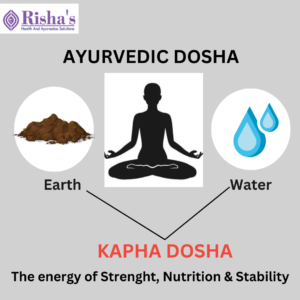
Kapha dosha ? It is energy that provides bala (strength) and regulates the growth of the body. Shelesma, Balasa, Balasaka and Soma are the it’s synonyms .
The word kapha is derived ffrom “kena jalena pihalati iti kapha” which means water is the basis of kapha formation.
Ayurveda the ancient system of health and well-beign believes in theory of Tridosha ,the three energies that are responsible for good health as well as illness. These three energies are Vata, Pitta, Kapha. The kapha dosha is energy for strength , pitta dosha is energy for digestion and vata dosha is energy of movement.
What is Kapha Dosha
Kapha is a combination of two elements namely jala (water) and prithvi (earth). In addition to this satva and tama are the qualities associated with Kapha . Among all the three dosha kapha is responsible for the strength of the body.
To understand Kapha easily just compare it with the water avaialable in the nature . The water helps in nuturing all the things outside in the same kapha helps in nuturing the body.
Kapha represent water element in our physical body. It is also said to be representative of moon in the body. The water and the moon both are cooling in nature and so is kapha.
Also read Basics of Ayurveda: Learn about Vata, Pitta, Kapha
Defination
The one which has got its origin and nuturing from water is known as Kapha.
From this defination it is clear that kapha is originated from water and it is predominant part of it. This also makes us understand that kapha represent water in the human body.
Qualities of Kapha dosha
Guru ( Heavy) : Means it is heavy in nature and causes heavyness in body.
Sheet (cold) : It is cold in nature which aids calming of pitta .
Snigdha ( Unctous) : This means quality of oilyness.
Pichchila (slimy) : Kapha is slimy in nature . It increases in cold wheather.
Mrudu (soft): Means it gives smoothness.
Sthira (Stable) : It gives stability to body parts
Manda ( Sluggish) : It makes person slow in activities.
Sandra ( Compact) :
Where is Kapha located in the body
It is primarily located in the urdhwa amashaya ( upper part of the stomach). However the Ura ( chest ) is the main seat of kapha dosha.
In addition to this it is located in shira ( head), greeva( neck), sandhi (joints), kantha ( throat), ras (plasma), meda(fat), ghrana(nose),jihva (tongue).
Sub Types of Kapha dosha
Kapha has five subtypes and have different functions in the body. They are as follows
- Avalambaka : It is situated in chest, trika pradesha,( it is point where three point meet ) supports other type of kapha by providing nourihment.
- Tarpak : It resides in shir ( head) and regulates functions of sense organs.
- Bodhak : It is located at the root of the tongue and throat and is helpful in the perception of the taste.
- Shleshaka : It is present in the joints, maintains lubrication of the joints and carries smooth functioning of joints.
- Kledaka : This is present in the amashya( stomach) and hence aids in the proper mixing of the food and softens the food particles for easy digestion.
Normal Functions of Kapha in body
- Gauravata– provides heaviness in the body.
- Snehana– the unctuousness (moisture)of the body is maintained by the snehana quality of the kapha dosha. It helps in flexibilty and easy movements of the body parts.
- Sthirata– The firmness or the stability of all the structures in the body and the mental stability brought by Kapha .
- Bandhana– The bones, joints, tendons, ligaments, tissues, and cells bind to each other with the help of water and earth element.
- Bala– Kapha gives strength to the body. Improves immunity.
- Upachaya– The growth of the body is dependent on it.
- Vrishata– The reproductive system functions are carried out by kapha .
- Kapha has a role in the intellect and knowledge of a person.
What cause Kapha to Increase
According to the Ayurveda the diet and lifestyle factors that are similar to qualities of kapha will lead to increase kapha in the body. Like
- Food items that tend to increase kapha are sweets and dairy products, fast and junk food, and food items that are kept in cold storage of refrigerator.
- Excessive consumption of sweet, sour, and salty taste.
- Living in extreme cold conditions or in air conditioners for too long time
- Sleeping during day time.
- Lack of excercise and sedentary lifestyle .
- Suppression of natural body urges such as urination, crying, burping, farting etc.
- Some profession like IT, bank employees,have more possibilities of kapha dosha aggravation.
What happens when Kapha gets Imbalanced
When kapha is imbalanced it leads to two types
1. Vriddhi : it means increase
2. Kshay: it means decrease
Kapha Vriddhi lakshana (symptoms of increased Kapha )
- Gauravata (heaviness in the body)
- Alasya(fatigue)
- Shukla varnata of twacha (whitish discoloration of the skin)
- Avasada (depression)
- Agnisada (impaired digestion)
- Sandhivishlesha (joints get loosened)
- Praseka (excess salivation)
- Atinidrata (excess sleep)
- Tandra (drowsiness)
- Shwasa (breathlessness)
- Kasa (cough)
- Sthaulya (obesity)
- Hrillasa (nausea)
- Murcha (syncope), etc.
Kapha Kshaya lakshana(symptoms of decreased Kapha )
- Rukshata (roughness of the skin)
- Anidra (loss of sleep)
- Bhrama (giddiness)
- Daurbalya (weakness)
- Antardaha (internal burning sensation)
- Trishna (thirst)
- Vepathu(tremors),
- Hridayadrava(palpitation) etc.
Kapha relation with Day
All the dosha’s in the body have influence acording to the age, season, during 24 hours in a day. For Kapha, it is predominant in the body at following time of the day.
In Morning between 6 Am to 10 Am
In Evening betwwen 6 Pm to 10 Pm.
So when there is imbalance in the body the symptoms of the diseases are seen more during this time .
Kapha relation with Season
Kapha dosha tends to accumulate in the winter season ( shishir ritu). It aggravates in the spring season ( Vasant ritu). This is the reason problems realted with this like asthma, allergy, indigestion, itching, low immunity are seen in spring season.
So to prevent problems in spring season it is advised to take diet that helps to keep vata in balance. Vasant ritucharya described in ayurveda should be adopted .
Kapha relation with Age
Kapha is predominant in the childhood period of person . The childhood is known as phase of Kapha dosha.
So to prevent this problems one should start taking rasayana herbs and kapha har herb, external application of medicated oil. Along with this person should prefer diet and lifetsyle that helps to balance water and earth element.
Kapha and Digestive fire
The Agni ( Digestive fire) is the essence of life and it is affected by the state of dosha in the body.
When Agni is affected with kapha then its start behaving in a slow manner ( mandagni), that means the Agni will take a long time for the food to be digested irrespective of the quantity.This is known as Mandagni in Ayurveda.
Those who have mandagni tends to suffer from kapha type of indigestion which is known as Amajerrna ajeerna.
During the digestion process in the initial phase kapha increases in the stomach. This phase in known as Madhur Awasthapak.
Kapha and Bowel movement
When kapha increases in the bowel or in people who have kapha prakriti then this bowel is known as Madhyam koshta. This means these people will have some difficulty in passing stool and have constipation, there stool becomes sticky. In these people soft laxative don’t work and may requires use of purgatives for elimination of waste material.
Conclusion
The Kapha is one of dosha and is responsible for strenght in the body, smooth functioning of joints and all the sense organs. When in balanced state it brings energy to life, stability and calmness. However when it is imbalanced kapha leads to many diseases in the body. It has deep relation with digestive fire, different seasons and age of person. By keeping kapha in balance one can prevent many diseases and even delay the ageing process.
This Article is written by Dr. Ashutosh Tiwari B.A.M.S, PGDCR Director of Risha’s Health And Ayurvedaa Solutions.He is having more than 20 years of experience in field of Ayurvedic medicine.


